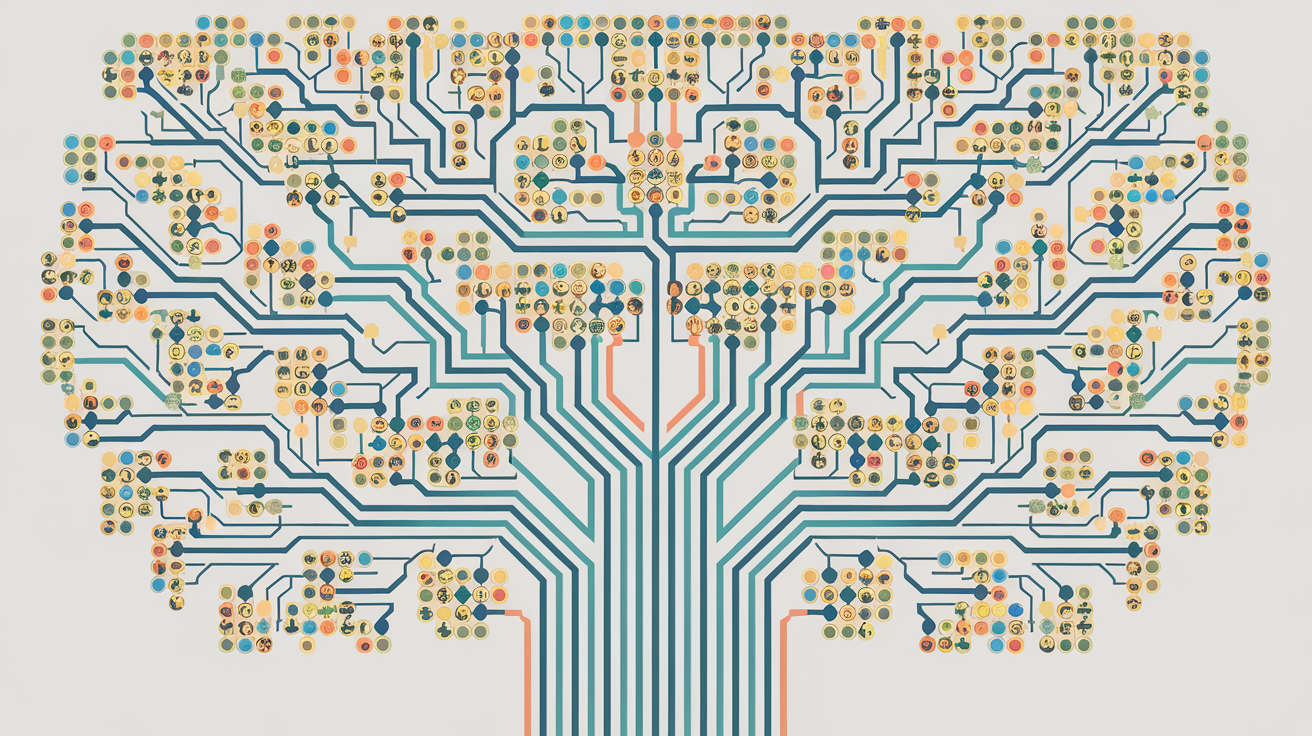Ever notice how some family trees have 200 people while others have 200,000?
Weird, right?
I’ve spent years observing this strange divide in our genealogy community. Some researchers meticulously document every fact about fewer relatives. Others race to connect as many branches as possible.
Neither approach is wrong. But they reveal something profound about who we are as researchers.
Understanding why we build trees the way we do helps us make better choices about our research. It shows us our blind spots. And it forces us to confront the real purpose behind all those hours hunting for records.
The Two Schools of Genealogical Thought
Let me be direct: there are two types of genealogists in this world.
The quality people and the quantity people.
Quality-focused researchers are obsessed with verification. Every. Single. Fact. Must. Be. Proven.
They don’t just add names. They reconstruct lives. They can tell you not just when their 3rd-great-grandfather was born, but what crops he planted, what church he attended, and which neighbors he argued with.
I know one researcher who spent 40 years building a tree of just 560 people. That’s painfully small by some standards. But he can “stand over every single individual” with absolute confidence. No guesses. No maybes.
Then there are the quantity-focused researchers.
These folks maintain massive networks. They’re pattern hunters. They see connections across centuries that others miss because they have the broader context.
One historian I follow maintains a tree of more than 470,000 people. Insane, right? But he uses it as “reference notes” for historical work, tracking how communities formed and shifted over generations.
He doesn’t claim every connection is bulletproof. That’s not the point of his research.
The Psychology Behind “Name Collecting”
Let’s talk dopamine.
Finding a new ancestor triggers the same reward systems in your brain as gambling, shopping, or scrolling social media. Click. New relative. Dopamine hit. Repeat.
The satisfaction is immediate. The verification? That’s work. Hard work.
Many genealogists are essentially puzzle solvers wearing history hats. The thrill comes from cracking cases no one else has solved.
“I found Great-Great-Grandpa’s military pension record that no one knew existed!”
This parallels other collecting hobbies:
The drive for completeness. (“I need all 16 great-great-grandparents, AND their siblings!”)
The thrill of the hunt. (“Just one more record search before bed…”)
The joy of organizing and cataloging. (“My color-coding system for document types is magnificent!”)
And let’s be honest: genealogy platforms know this. They’ve gamified the whole experience.
Those shaky leaves? Ancestry’s version of a slot machine payout.
That suggested connection? MyHeritage’s dopamine delivery system.
One click adds an ancestor. One click requires no skill. One click feels productive.
But verification? That takes discipline. That’s delayed gratification in a world trained for instant rewards.
The Evolution of a Genealogist
Most of us start as collectors.
Names. Dates. Places. More is better.
But something fascinating happens over time. We evolve.
The names become people. The dates become life events. The places become communities.
We transform from collectors into historians.
This evolution typically follows a predictable path: from breadth first to depth later.
I’ve watched countless genealogists make this transition. They start by mapping vast branches of distant cousins, then gradually narrow their focus to understand fewer ancestors more deeply.
As one researcher told me: “Genealogy teaches you a lot about why you are the way you are.”
That insight rarely comes from collecting 10,000 fifth cousins. It comes from deeply understanding your direct ancestors and their immediate families.
This growth happens through:
- Education about methodology. Learning how to evaluate evidence properly.
- Community feedback. Having experienced researchers point out your assumptions.
- Personal investment in ancestors’ stories. Finding yourself caring about their lives, not just their vital statistics.
The collector becomes the storyteller. The hobbyist becomes the historian.
This transformation is the true reward of genealogy.
Identity and Connection: Why We Build Trees
Ever wonder why some people have zero interest in genealogy while others become obsessed?
It’s about identity.
Our trees help establish who we are. They create belonging. They connect us to history through blood and marriage instead of just textbooks.
The motivations driving genealogists are complex:
For some, it’s the detective work. The intellectual challenge of tracking people across centuries with minimal evidence.
For others, it’s understanding their personal origin story. Why do I have this trait? Why does our family value this tradition?
Many live vicariously through ancestral stories. We find meaning in their struggles and triumphs.
And almost all of us get a thrill from finding connections to historical events. “My 4th-great-grandmother lived three miles from the Battle of Gettysburg!”
The Impact of Technology on Tree Building Psychology
Digital platforms have radically changed researcher behavior.
Twenty years ago, building a 10,000-person tree meant decades of library visits, cemetery trips, and correspondence. The physical effort limited tree size.
Now? You can add 100 ancestors in an afternoon of “leaf clicking.”
Technology has created new psychological traps:
- The temptation to copy from public trees without verification.
- DNA matching algorithms encouraging broader but shallower trees.
- The social validation that comes from impressive numbers.
Online communities subtly reward quantity. “Wow, your tree has 25,000 people? You must be an expert!”
Size isn’t expertise. Documentation is.
The Challenge of Accuracy in Larger Trees
Let’s face reality.
Every person you add to your tree increases your chance for error. Simple math.
When your tree hits 10,000 people, you’re juggling 10,000 opportunities to mess up. And those mistakes compound.
The most common verification nightmares haunt every genealogist:
- Multiple John Smiths born within five years in the same county. Which one is yours?
- A marriage that seems perfect on paper but would require your ancestor to travel 200 miles in 1795. Possible? Yes. Likely? No.
- A mother who would have been 60 at childbirth in an era when that was practically unheard of.
These red flags get missed in the excitement of expansion.
Too many researchers treat verification as optional. It’s not.
Every unverified connection that gets published online becomes “truth” when another researcher copies it.
Your guess becomes someone else’s fact.
Let me say that again: Your guess becomes someone else’s fact.
This is how entire fictional family lines propagate through the genealogy world. One unverified assumption gets copied thousands of times.
The solution isn’t complicated:
- Mark uncertain connections clearly.
- Keep speculative branches private until verified.
- Document your sources meticulously.
But simple doesn’t mean easy. Discipline rarely is.
Legitimate Uses for Quantity-Focused Research
I’m not anti-big-tree. Far from it.
Broad trees serve crucial research purposes when built intentionally.
Surname studies tracking how the Johnsons spread across five states from a single immigrant ancestor? That requires scale.
Community reconstruction projects mapping every resident of a small town across generations? You need hundreds or thousands of interconnected people.
DNA match analysis becomes exponentially more powerful with robust trees.
The difference? Purpose.
These aren’t random name collections. They’re targeted research with specific goals requiring breadth.
Collaborative genealogy also improves quality through shared expertise. Twenty researchers checking each other’s work catch mistakes that solo researchers miss.
The key is intentionality. Build big if your research requires it. Not because big feels impressive.
Finding Your Balance: Building a Tree That Satisfies
There’s no “correct” tree size. That’s critical to understand.
Your research approach should align with your personal goals:
- Are you more interested in life stories or broad connections?
- How much time can you realistically invest in verification?
- Are you working alone or collaborating with family members?
Consider these factors honestly when choosing your path.
Regardless of your approach, certain best practices remain non-negotiable:
- Document your sources clearly. Always.
- Review and correct regularly. Set aside time to clean house.
- Be transparent about confidence levels. “Proven” and “speculative” aren’t the same.
- Set intentional research goals instead of growing randomly.
- The right balance feels satisfying. You’ll know it when you find it.
For some, that’s 500 people with rock-solid documentation. For others, it’s 5,000 with varying levels of verification but clear markers of confidence.
Either way, the choice is yours to make.
Final Thoughts
Before I get off my soapbox, a few final thoughts.
Here’s the truth: You should build your family tree however you damn well please.
If collecting thousands of distant cousins brings you joy, do it.
If meticulously documenting every fact about your direct line fulfills you, perfect.
But remember this: With shared research comes responsibility.
Unverified information spreads like wildfire. What you add to public trees affects thousands of other researchers.
One careless connection can send hundreds of people down the wrong ancestral path.
The ripple effect is real. And permanent.
If you maintain a large tree with varying verification levels, consider these precautions:
- Use private AND unsearchable trees for research still under investigation.
- Add clear confidence ratings to each fact and relationship.
- Implement your own verification system before making discoveries public.
The genealogy community thrives on shared knowledge. But that knowledge is only as good as its weakest source.
Quality and quantity aren’t mutually exclusive. The best researchers find ways to balance both.
They build trees that satisfy their research goals while respecting the collaborative nature of our work.
Your ancestors’ stories deserve nothing less than your best effort.
Whether your tree contains 200 people or 200,000, make each connection count.



My tree is a mix. There are many people in my tree that are there only to help me find a dna connection. Other people in my tree are well documented. The reasons for doing a deep dive vary. Sometimes it’s random and sometimes, deeply personal. The ripple effect is real but it’s not permanent. It takes effort to get people to correct an error that is copied to hundreds of trees but it can be done. The trick is to put a lot of pictures, sources, etc… in the profile (at least for Ancestry) so your tree comes up first when people search public trees. You can also set up multiple trees on Ancestry with the correct results and load them with sources, pictures, etc… so they come up first in the tree search results. You do also have to reach out to others whose trees come up on the first page of tree search results. When the top trees have accurate information, it will start to perpetuate when when people are copying pasting.
I think that my 3rd great grandmother Sarah Keaton was the daughter of Isaac Basye. I entered it into my Ancestry tree, clearly labeled as speculation. Now I see it on some trees and on findagrave as fact with no source info. Makes me sick!
I have recently converted from quantity to quality. The increased satisfaction is life changing.